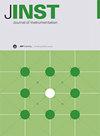Novel reconstruction method of angle-limited backprojection (ALBP) for low-dose dental panoramic X-ray imaging
IF 1.3
4区 工程技术
Q3 INSTRUMENTS & INSTRUMENTATION
引用次数: 0
Abstract
Abstract Panoramic radiography is a popular two-dimensional X-ray imaging modality in dentistry. It produces a single image of the overall facial view, including the maxillary and mandibular arches and supporting structures. Panoramic images are typically reconstructed using the shift-and-add (SAA) algorithm, in which only structures within a certain image layer are in focus, and others are out of focus on the panoramic image. As the clinical use of panoramic radiography has grown rapidly, radiologists are continuously seeking ways to reduce the radiation dose to patients. This study proposes a novel panoramic reconstruction method called the angle-limited backprojection (ALBP) algorithm for low-dose panoramic X-ray imaging. In ALBP, X-rays that meet the angular criterion established in this study are selected from the measured panoramic projection data and then backprojected onto the spherical voxels placed along the dental arch, as in a typical computed tomography reconstruction. The angular criterion selects X-rays that pass through a given spherical voxel and simultaneously have directional vectors within a prespecified angular range concerning the directional vector at the corresponding source position. To validate the efficacy of the proposed reconstruction method, we conducted a numerical simulation and experiment and investigated the image characteristics. Panoramic images were reconstructed using the SAA and ALBP algorithms with full and half (i.e., half radiation dose) panoramic projections, and their image quality was quantitatively evaluated using the intensity profile and universal quality index (UQI). The image quality of the ALBP with half projections was similar to that of the SAA with full projections, indicating the efficacy of the proposed method. Accordingly, our results demonstrated the potential for radiation dose reduction in panoramic X-ray imaging.低剂量牙科全景x线成像的角度限制反向投影(ALBP)重建方法
全景x线摄影是一种流行的牙科二维x线成像方式。它产生一个整体面部视图的单一图像,包括上颌和下颌弓和支持结构。全景图像的重建通常使用移加算法(SAA),其中只有某一图像层内的结构是对焦的,而其他结构在全景图像上是失焦的。随着全景放射摄影在临床应用的迅速发展,放射科医师不断寻求降低患者放射剂量的方法。本研究提出了一种新的低剂量全景x射线成像全景重建方法——角度限制反投影(ALBP)算法。在ALBP中,从测量的全景投影数据中选择符合本研究建立的角度标准的x射线,然后将其反投影到沿牙弓放置的球形体素上,就像典型的计算机断层扫描重建一样。角度准则选择x射线,通过一个给定的球面体素,同时有一个预先指定的角度范围内的方向矢量有关的方向矢量在相应的源位置。为了验证所提出的重建方法的有效性,我们进行了数值模拟和实验,并对图像特征进行了研究。采用SAA和ALBP算法对全投影和半投影(即半辐射剂量)全景图像进行重构,并采用强度剖面和通用质量指数(UQI)对其图像质量进行定量评价。半投影的ALBP图像质量与全投影的SAA图像质量相当,表明了所提方法的有效性。因此,我们的结果证明了在全景x射线成像中降低辐射剂量的潜力。
本文章由计算机程序翻译,如有差异,请以英文原文为准。
求助全文
约1分钟内获得全文
求助全文
来源期刊

Journal of Instrumentation
工程技术-仪器仪表
CiteScore
2.40
自引率
15.40%
发文量
827
审稿时长
7.5 months
期刊介绍:
Journal of Instrumentation (JINST) covers major areas related to concepts and instrumentation in detector physics, accelerator science and associated experimental methods and techniques, theory, modelling and simulations. The main subject areas include.
-Accelerators: concepts, modelling, simulations and sources-
Instrumentation and hardware for accelerators: particles, synchrotron radiation, neutrons-
Detector physics: concepts, processes, methods, modelling and simulations-
Detectors, apparatus and methods for particle, astroparticle, nuclear, atomic, and molecular physics-
Instrumentation and methods for plasma research-
Methods and apparatus for astronomy and astrophysics-
Detectors, methods and apparatus for biomedical applications, life sciences and material research-
Instrumentation and techniques for medical imaging, diagnostics and therapy-
Instrumentation and techniques for dosimetry, monitoring and radiation damage-
Detectors, instrumentation and methods for non-destructive tests (NDT)-
Detector readout concepts, electronics and data acquisition methods-
Algorithms, software and data reduction methods-
Materials and associated technologies, etc.-
Engineering and technical issues.
JINST also includes a section dedicated to technical reports and instrumentation theses.
 求助内容:
求助内容: 应助结果提醒方式:
应助结果提醒方式:


